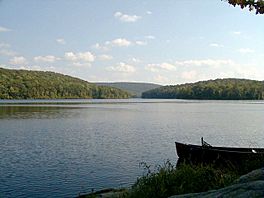Lake Sebago facts for kids
Quick facts for kids Lake Sebago |
|
|---|---|

The lake in 2001
|
|
| Location | Harriman State Park, Rockland County, New York, U.S. |
| Coordinates | 41°11′50″N 74°08′08″W / 41.19722°N 74.13556°W |
| Etymology | Algonquian word for "big water" |
| Primary outflows | Stony Brook |
| First flooded | 1925 |
| Surface area | 310 acres (1.3 km2) |
Lake Sebago is the biggest lake in Harriman State Park in New York. It covers about 310 acres (1.25 square kilometers). Its name comes from the Algonquian people, and it means "big water."
The Palisades Interstate Park Commission manages Lake Sebago. It is a popular spot for outdoor fun. You can find picnic areas and fields around the lake. Many people enjoy fishing here for bass, perch, and sunfish. The lake also has a boat launch for electric motors only. You can even go cabin camping nearby.
Lake Sebago is close to Sloatsburg. It is just south of Lake Kanawauke. You can reach it by car from Seven Lakes Drive. There used to be a swimming beach called New Sebago Beach. It opened in the 1940s but closed in 2011. This was because of damage from Hurricane Irene. The picnic areas also closed in 2014 after Hurricane Sandy. New Sebago Beach and its parking lot are now closed.
Contents
History of Lake Sebago
How the Lake Was Made
Lake Sebago was created in 1925. The Palisades Interstate Park Commission built a dam across Stony Brook. This project was led by William A. Welch. The lake then filled up a valley. This valley used to be the site of an old settlement called Johnsontown.
Johnsontown Settlement
Johnsontown was a logging village founded in the mid-1700s. It was in the Stony Brook valley. By the early 1900s, it was the largest mountain village in the western Ramapos.
In 1916 and 1917, the park commission bought the land. They said the village was built on swampy ground. Many families moved to nearby Sloatsburg. The park commission took over the land. All the homes, stores, the school, and the church were torn down. Then, the Stony Brook valley was flooded to make Lake Sebago. If you go scuba diving, you can still see parts of the old Johnsontown sawmill underwater!
Camps on the Lake
Several groups have camps on Lake Sebago. The American Canoe Association has a camp there. The New York chapter of the Adirondack Mountain Club also has a camp called "Nawakwa." This camp has been there since 1926. The American Canoe Association's camp was built in 1928. They took it over in 1933.
In 1927, a camp was built for people who worked at four New York City banks. In 1986, this camp started offering cabin camping to the public. Also in 1927, New York University opened a camp. They used it until 1961. Today, its facilities are also open for public use.
Images for kids
-
Canada goose with goslings







